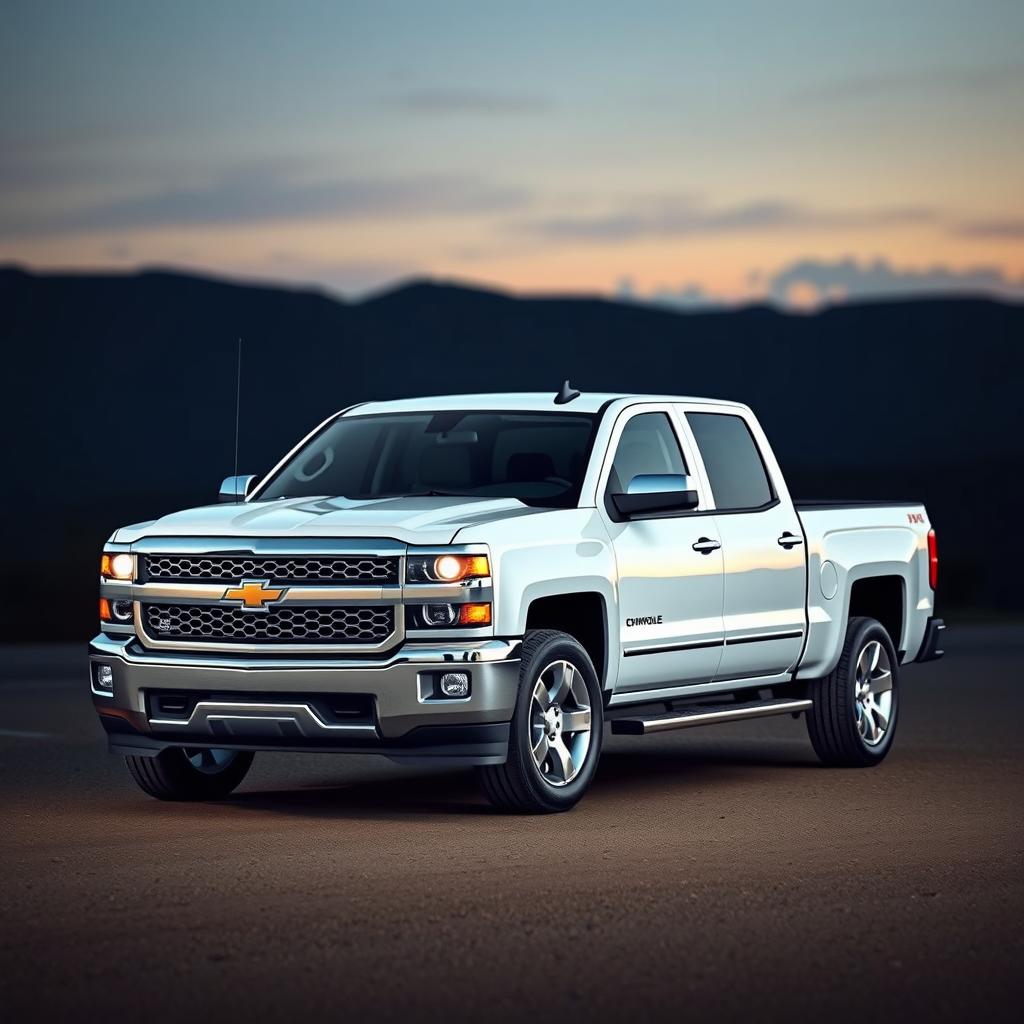How Much Does A Chevy Silverado Weigh?
“`html
Ever wondered exactly how much a Chevy Silverado weighs?
Understanding the Weight of a Chevy Silverado
Figuring out the weight of your Chevy Silverado isn’t just about satisfying curiosity.
It directly impacts payload capacity, towing capability, and even fuel efficiency.
Let’s break down what influences a Silverado’s curb weight and gross vehicle weight rating (GVWR).
Curb Weight vs. GVWR: What’s the Difference?
Curb weight is the weight of your Silverado as it sits, fresh from the factory, with standard equipment, fluids full, but without passengers or cargo.
GVWR, or Gross Vehicle Weight Rating, is the maximum allowable weight of your Silverado, including the truck itself, passengers, cargo, and any tongue weight from a trailer.
Essentially, GVWR is the curb weight plus everything you add to it.
Factors Influencing the Chevy Silverado Weight
Several key elements influence how much a Chevy Silverado weighs, and understanding these is crucial.
- Cab Configuration: Regular cab, double cab, and crew cab Silverados all have different weights due to varying amounts of materials used.
- Bed Length: A longer bed means more steel, which directly increases the overall truck weight.
- Engine Type: The engine you choose plays a significant role; a smaller, lighter engine will result in a lower overall weight compared to a larger, more powerful one.
- Drivetrain: Two-wheel drive (2WD) models are generally lighter than four-wheel drive (4WD) models due to the added components of the 4WD system.
- Trim Level: Higher trim levels often include more features and heavier materials, like leather seats or advanced tech, that add to the curb weight.
Chevy Silverado 1500 Weight: A Closer Look
The Chevy Silverado 1500 is the most popular model, so let’s drill down into its typical weight range.
Generally, a Silverado 1500’s curb weight can range from approximately 4,500 pounds to over 5,300 pounds, depending on the specific configuration.
For example, a 2WD regular cab with a smaller engine will be on the lighter end, while a 4WD crew cab with a larger engine and all the bells and whistles will be closer to the heavier end of the spectrum.
Chevy Silverado 2500HD and 3500HD Weight: Heavy Duty Specs
Moving into the heavy-duty territory, the Silverado 2500HD and 3500HD models are built for serious work, and their weight reflects that.
The 2500HD typically weighs in around 6,200 to 7,400 pounds, while the 3500HD can range from 6,600 to well over 8,000 pounds, depending on the configuration.
These heavier trucks are designed to handle larger payloads and tow heavier trailers, so their robust construction adds to their overall weight.
Finding the Exact Weight of Your Silverado
Want to know the specific weight of *your* Chevy Silverado?
Here’s where to look:
- Driver’s Side Doorjamb: Check the sticker on the driver’s side doorjamb; it usually lists the curb weight and GVWR.
- Owner’s Manual: Your owner’s manual will provide detailed specifications for your specific model, including weight information.
- Online Resources: Chevrolet’s website or other automotive databases often have detailed specs for different Silverado models and years.
- Local Weigh Station: For the most accurate measurement, especially if you’ve made modifications to your truck, visit a local weigh station.
Why Silverado Weight Matters
Understanding the weight of your Chevy Silverado isn’t just trivia; it’s practical knowledge.
Knowing the curb weight helps you estimate fuel consumption, while understanding the GVWR is crucial for safe loading and towing.
Overloading your truck can damage its components, reduce its lifespan, and even create a safety hazard.
Plus, exceeding weight limits can lead to fines and legal issues.
Weight and Towing Capacity
The weight of your Silverado directly affects its towing capacity.
The heavier the truck, the more it can generally tow, up to the manufacturer’s specified limit.
However, it’s not just about the truck’s weight; you also need to consider the engine, axle ratio, and other factors that contribute to towing performance.
Always consult your owner’s manual to determine the safe towing capacity for your specific Silverado model.
Weight and Fuel Economy
Weight is a significant factor in fuel economy.
A heavier Silverado requires more energy to move, which translates to lower MPG.
If fuel efficiency is a priority, consider a lighter configuration with a smaller engine and 2WD.
Modifications and Weight
Any modifications you make to your Silverado can impact its weight.
Adding aftermarket bumpers, winches, or lift kits will increase the curb weight and reduce the available payload capacity.
Keep this in mind when planning modifications and ensure you stay within the GVWR.
So, next time someone asks, you’ll know exactly how much a Chevy Silverado weighs and why it matters.
“`  “`html
“`html
Ever wondered exactly how much a Chevy Silverado weighs?
Understanding the Weight of a Chevy Silverado
Figuring out the weight of your Chevy Silverado isn’t just about satisfying curiosity.
It directly impacts payload capacity, towing capability, and even fuel efficiency.
Let’s break down what influences a Silverado’s curb weight and gross vehicle weight rating (GVWR).
Curb Weight vs. GVWR: What’s the Difference?
Curb weight is the weight of your Silverado as it sits, fresh from the factory, with standard equipment, fluids full, but without passengers or cargo.
GVWR, or Gross Vehicle Weight Rating, is the maximum allowable weight of your Silverado, including the truck itself, passengers, cargo, and any tongue weight from a trailer.
Essentially, GVWR is the curb weight plus everything you add to it.
Factors Influencing the Chevy Silverado Weight
Several key elements influence how much a Chevy Silverado weighs, and understanding these is crucial.
- Cab Configuration: Regular cab, double cab, and crew cab Silverados all have different weights due to varying amounts of materials used.
- Bed Length: A longer bed means more steel, which directly increases the overall truck weight.
- Engine Type: The engine you choose plays a significant role; a smaller, lighter engine will result in a lower overall weight compared to a larger, more powerful one.
- Drivetrain: Two-wheel drive (2WD) models are generally lighter than four-wheel drive (4WD) models due to the added components of the 4WD system.
- Trim Level: Higher trim levels often include more features and heavier materials, like leather seats or advanced tech, that add to the curb weight.
Chevy Silverado 1500 Weight: A Closer Look
The Chevy Silverado 1500 is the most popular model, so let’s drill down into its typical weight range.
Generally, a Silverado 1500’s curb weight can range from approximately 4,500 pounds to over 5,300 pounds, depending on the specific configuration.
For example, a 2WD regular cab with a smaller engine will be on the lighter end, while a 4WD crew cab with a larger engine and all the bells and whistles will be closer to the heavier end of the spectrum.
Chevy Silverado 2500HD and 3500HD Weight: Heavy Duty Specs
Moving into the heavy-duty territory, the Silverado 2500HD and 3500HD models are built for serious work, and their weight reflects that.
The 2500HD typically weighs in around 6,200 to 7,400 pounds, while the 3500HD can range from 6,600 to well over 8,000 pounds, depending on the configuration.
These heavier trucks are designed to handle larger payloads and tow heavier trailers, so their robust construction adds to their overall weight.
Finding the Exact Weight of Your Silverado
Want to know the specific weight of *your* Chevy Silverado?
Here’s where to look:
- Driver’s Side Doorjamb: Check the sticker on the driver’s side doorjamb; it usually lists the curb weight and GVWR.
- Owner’s Manual: Your owner’s manual will provide detailed specifications for your specific model, including weight information.
- Online Resources: Chevrolet’s website or other automotive databases often have detailed specs for different Silverado models and years.
- Local Weigh Station: For the most accurate measurement, especially if you’ve made modifications to your truck, visit a local weigh station.
Why Silverado Weight Matters
Understanding the weight of your Chevy Silverado isn’t just trivia; it’s practical knowledge.
Knowing the curb weight helps you estimate fuel consumption, while understanding the GVWR is crucial for safe loading and towing.
Overloading your truck can damage its components, reduce its lifespan, and even create a safety hazard.
Plus, exceeding weight limits can lead to fines and legal issues.
Weight and Towing Capacity
The weight of your Silverado directly affects its towing capacity.
The heavier the truck, the more it can generally tow, up to the manufacturer’s specified limit.
However, it’s not just about the truck’s weight; you also need to consider the engine, axle ratio, and other factors that contribute to towing performance.
Always consult your owner’s manual to determine the safe towing capacity for your specific Silverado model.
Weight and Fuel Economy
Weight is a significant factor in fuel economy.
A heavier Silverado requires more energy to move, which translates to lower MPG.
If fuel efficiency is a priority, consider a lighter configuration with a smaller engine and 2WD.
Modifications and Weight
Any modifications you make to your Silverado can impact its weight.
Adding aftermarket bumpers, winches, or lift kits will increase the curb weight and reduce the available payload capacity.
Keep this in mind when planning modifications and ensure you stay within the GVWR.
So, next time someone asks, you’ll know exactly how much a Chevy Silverado weighs and why it matters.
Digging Deeper: How the Chevy Silverado’s Weight Affects Performance
It’s not just about the numbers; it’s about how those numbers play out on the road.
The **weight** of your Chevy Silverado is a key player in its overall performance, influencing everything from acceleration to braking.
Let’s explore how this works.
Acceleration and the Silverado’s Weight
Think of it this way: the lighter the truck, the quicker it can accelerate.
A Silverado 1500 with a lower **curb weight** will generally feel more responsive than a heavier 2500HD or 3500HD.
However, engine power also comes into play, a beefier engine can compensate for the extra weight, but there will be fuel consumption trade off.
Braking Performance and Vehicle Weight
Stopping a heavy truck requires more effort and distance.
The **gross vehicle weight rating (GVWR)** is especially important here.
The closer you are to the GVWR, the longer it will take to stop, which can be critical in emergency situations.
Regular maintenance of your brake system is a must, especially if you often haul heavy loads.
Handling and Stability: The Role of Weight Distribution
Weight distribution is just as important as the total **weight**.
A well-balanced Silverado will handle better and feel more stable, especially when cornering or driving on uneven surfaces.
When loading cargo, try to distribute the weight evenly to maintain good handling.
Chevy Silverado Weight and Tire Selection
Your tires are the only thing between your truck and the road, so choosing the right ones is crucial.
The **weight** of your Silverado, especially when loaded, dictates the type of tires you need.
Make sure your tires have a load rating that meets or exceeds the GVWR of your truck.
Using the wrong tires can lead to blowouts and accidents.
Comparing Silverado Weights Across Generations
The Chevy Silverado has evolved over the years, and so has its **weight**.
Newer models often incorporate new materials and technologies that can affect the overall weight, let’s compare generations:
- Older Generations: Generally, older Silverados might be slightly lighter due to less technology and fewer features, but this isn’t a hard and fast rule.
- Newer Generations: Newer models often have more safety features, larger cabs, and more powerful engines, which can increase **curb weight.**
Always check the specs for the specific year and model you’re interested in.
Maximizing Your Silverado’s Performance: Tips for Managing Weight
Want to get the most out of your Chevy Silverado?
Here are some practical tips for managing **weight** and maximizing performance:
- Know Your Limits: Always be aware of your truck’s GVWR and payload capacity.
- Distribute Cargo Evenly: Proper weight distribution improves handling and stability.
- Choose the Right Tires: Ensure your tires have the appropriate load rating.
- Regular Maintenance: Keep your brakes and suspension in good condition.
- Consider Weight-Saving Modifications: If performance is a priority, look for ways to reduce weight without sacrificing functionality.
Real-World Example: The Impact of Weight on a Chevy Silverado’s Towing Experience
I once helped a friend move using his Silverado 1500.
He was close to the GVWR, and we noticed a significant difference in braking distance and handling compared to when the truck was empty.
It was a real-world lesson in the importance of understanding your truck’s **weight** limits.
Decoding Silverado Trim Levels and Their Weight Implications
The trim level of your Silverado can also impact its **weight.**
Higher trim levels often come with more features, which can add to the overall curb weight.
For instance, a High Country trim might have leather seats, advanced audio systems, and other luxury features that increase the truck’s weight compared to a base Work Truck trim.
The Future of Silverado Weight: Materials and Technology
Automakers are constantly exploring new materials and technologies to reduce vehicle weight without compromising safety or performance.
Expect to see more aluminum, carbon fiber, and high-strength steel in future Silverado models, all aimed at optimizing the **weight**-to-performance ratio.
Frequently Asked Questions (FAQs)
What is the average weight of a Chevy Silverado 1500?
The average **weight** of a Chevy Silverado 1500 ranges from 4,500 to 5,300 pounds, depending on the configuration.
How does the engine affect the weight of a Silverado?
Larger, more powerful engines generally add more **weight** to the truck compared to smaller engines.
Where can I find the GVWR of my Chevy Silverado?
The GVWR is typically listed on a sticker on the driver’s side doorjamb or in your owner’s manual.
Does 4WD add weight to a Silverado?
Yes, four-wheel drive (4WD) models are generally heavier than two-wheel drive (2WD) models due to the added components of the 4WD system.
How does bed length influence the weight of a Silverado?
A longer bed means more steel, which directly increases the overall truck **weight**.
Conclusion
Understanding how much a Chevy Silverado weighs is essential for safe towing, optimal fuel economy, and overall performance.
“““html
“`


